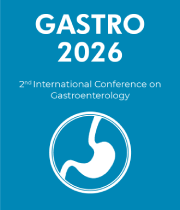Title : Serum pepsinogen I / II in patients with esophagogastroduodenoscopy and biopsy in two third level care institutions in Bogotá, Colombia
Abstract:
Background: Esophagogastroduodenoscopy (EGD) is the diagnostic imaging procedure of choice in the work-up of gastric carcinoma and chronic atrophic gastritis. Specialized personnel are scarce in areas of high occurrence and late diagnosis is frequent. Serum pepsinogen concentration (PEP) provides information on the morphological and functional status of the gastric mucosa. We described PEP I/II values and EGD + biopsy findings in patients attending to endoscopy services in two institutions in Bogota-Colombia, in order to provide infromation of how PEP I/II levels will be in population with usual gastrointestinal symptomatology.
Methods: Cross-sectional study in adult population requiring GED except gastrectomized patients from two high care level institutions in Bogotá, Colombia. Patientes were recruited by consecutive sampling (June to August 2019). Gastroenterologists followed institutional protocols for GED + biopsy. Blood samples were drawn from a peripheral vein before the EGD. Samples were sent to external laboratory to PEP subtype I and subtype II detection by chemiluminescence. We estimated 138 patients based on prevalence of chronic gastritis (18%) in our institution using proportion estimate formula α=8 0.10, β= 0.8. Descriptive statistics were used and the pepsinogen I/II ratio was calculated. All participants signed informed consent and protocol was approved by the Ethics Committee in both institutions.
Results: Data were collected from 108 patients. Median (Me) age 63 years (Q1:53 ; Q3:71), women accounted for 74%. PEP I/II levels Me 7 (Q1: 5 ; Q3: 10). We did not find differences among patientes with atrofic gastritis and other patologies in esdoscopies or biopsies reports. We did not found evidence to reject diferences among PEP I/II medians among patientes H.pylori positive and H.pylori negative. We found atrophy in corporoantral region mainly.
Discussion: Our results identifyed some characteristics for diferente levels of PEP I/II detected by an ultrasensitive standardized technique, not jet commertial in the country. The included population characterize population with gastrointestinal symptomatology that attend to GDE services, reflecting real life patient conditions in Bogotá, Colombia. In the abscence of endoscopy and pathology standardization, the analyses have proven complicated. The PEP I/II levels did not differ when comparing patients with atrophy and othre patologies.
Audience Take Away:
- Different levels of PEP I/II will be used by researchers, for example in Systematic Literature Review, in order to elucidate utility of this biomarkers in stomach pathology diagnosis.
- We attempt to explore operational and logistic procedure, as well explore levels of PEP I/II in population with usual GI symptoms




